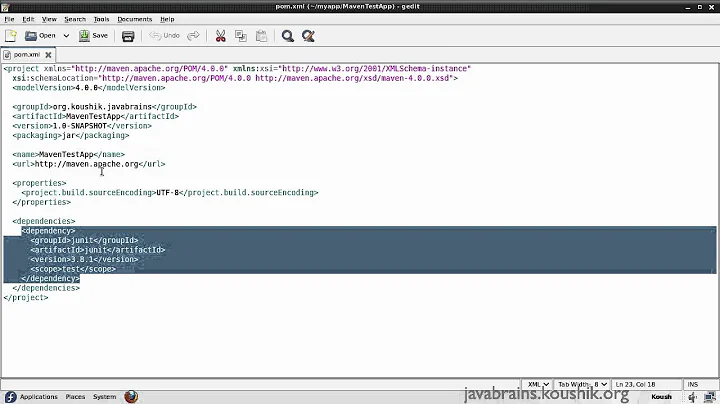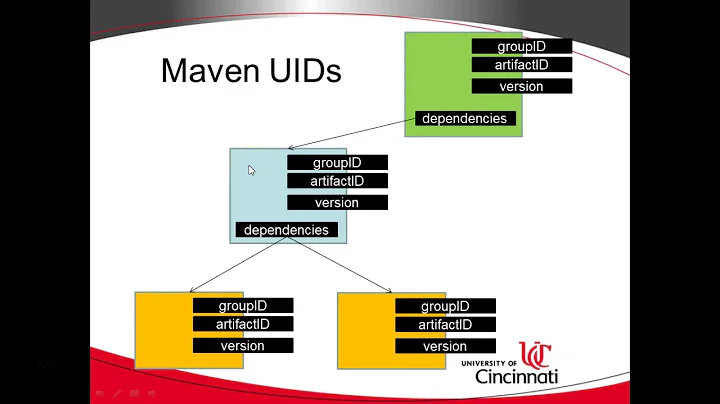What is the difference in maven between dependency and plugin tags in pom xml?
Solution 1
Both plugins and dependencies are Jar files.
But the difference between them is, most of the work in maven is done using plugins; whereas dependency is just a Jar file which will be added to the classpath while executing the tasks.
For example, you use a compiler-plugin to compile the java files. You can't use compiler-plugin as a dependency since that will only add the plugin to the classpath, and will not trigger any compilation. The Jar files to be added to the classpath while compiling the file, will be specified as a dependency.
Same goes with your scenario. You have to use spring-plugin to execute some spring executables [ I'm not sure what spring-plugins are used for. I'm just taking a guess here ]. But you need dependencies to execute those executables. And Junit is tagged under dependency since it is used by surefire-plugin for executing unit-tests.
So, we can say, plugin is a Jar file which executes the task, and dependency is a Jar which provides the class files to execute the task.
Hope that answers your question!
Solution 2
Maven itself can be described as food processor which has many different units that can be used to accomplish different tasks. Those units are called plugins. For example, to compile your project maven uses maven-compiler-plugin, to run tests - maven-surefire-plugin and so on.
Dependency in terms of maven is a packaged piece of classes that your project depends on. It can be jar, war etc. For example, if you want to be able to write JUnit test, you'll have to use JUnit annotations and classes thus you have to declare that your project depends on JUnit.
Solution 3
Plugins and dependencies are very different things and these are complementary.
What plugins are ?
Plugins perform tasks for a Maven build. These are not packaged in the application.
These are the heart of Maven.
Any task executed by Maven is performed by plugins.
There are two categories of plugins : the build and the reporting plugins :
- Build plugins will be executed during the build and they should be configured in the
<build/>element from the POM. - Reporting plugins will be executed during the site generation and they should be configured in the
<reporting/> element from the POM.
According to the maven goal specified in the command line (for example mvn clean, mvn clean package or mvn site) , a specific lifecyle will be used and a specific set of plugins goals will be executed.
There are three built-in build lifecycles: default, clean and site. The default lifecycle handles your project deployment, the clean lifecycle handles project cleaning, while the site lifecycle handles the creation of your project's site documentation.
A plugin goal may be bound to a specific phase of a specific lifecyle.
For example the maven-compiler-plugin binds by default the compile goal to the lifecycle phase: compile.
Most of maven plugins (both core plugins and third party plugins) favor convention over configuration. So these generally bound a plugin goal to a specific phase to make their usage simpler.
That is neater and less error prone :
<plugin>
<artifactId>maven-compiler-plugin</artifactId>
<version>3.7.0</version>
</plugin>
than :
<plugin>
<artifactId>maven-compiler-plugin</artifactId>
<version>3.7.0</version>
<executions>
<execution>
<phase>compile</phase>
<goals>
<goal>compile</goal>
</goals>
</execution>
</executions>
</plugin>
What dependencies are ?
Dependencies are Maven artifacts/components required for the project.
Concretely most of dependencies are jar (that is libraries) but these may also be other kinds of archives : war, ear, test-jar, ejb-client ... or still POM or BOM.
In a pom.xml, dependencies may be specified at multiple places : the <build><dependencies> part , the dependencies management part or still in a plugin declaration ! Indeed some plugins may need to have some dependencies in the classpath during their execution. That is not common but that may happen.
Here is an example from the documentation that shows that plugin and dependency may work together :
For instance, the Maven Antrun Plugin version 1.2 uses Ant version 1.6.5, if you want to use the latest Ant version when running this plugin, you need to add
<dependencies>element like the following:
<project>
...
<build>
<plugins>
<plugin>
<groupId>org.apache.maven.plugins</groupId>
<artifactId>maven-antrun-plugin</artifactId>
<version>1.2</version>
...
<dependencies>
<dependency>
<groupId>org.apache.ant</groupId>
<artifactId>ant</artifactId>
<version>1.7.1</version>
</dependency>
<dependency>
<groupId>org.apache.ant</groupId>
<artifactId>ant-launcher</artifactId>
<version>1.7.1</version>
</dependency>
</dependencies>
</plugin>
</plugins>
</build>
...
</project>
In Maven, dependencies are referenced in a specific format :
groupId:artifactId:packaging:classifier:version.
The classifier (that is optional) and the packaging (JAR by default) are not commonly specified. So the common format in the dependency declaration is rather : groupId:artifactId:version.
Here is an example of dependency declared in the <build><dependencies> part :
<build>
<dependencies>
<dependency>
<groupId>org.hibernate</groupId>
<artifactId>hibernate-core</artifactId>
<version>5.2.14.Final</version>
</dependency>
<dependencies>
</build>
Dependency doesn't have a phase binding as plugins to address the "when" question.
But it has a counterpart : the scope.
Indeed declared dependencies are usable by the application at a specific time according to the scope we defined for these.
The scope is a central concept about how a dependency will be visible for the project.
The default scope is compile. That is the most commonly needed scope (convention over configuration again).
The compile scope means that the dependency is available in all classpaths of a project.
The scope defines in which classpaths the dependency should be added. For example do we need it at compile and runtime, or only for tests compilation and execution ?
For example we previously defined Hibernate as a compile dependency as we need it everywhere : source compilation, test compilation, runtime and so for....
But we don't want that testing libraries may be packaged in the application or referenced in the source code. So we specify the test scope for them :
<build>
<dependencies>
<dependency>
<groupId>org.junit.jupiter</groupId>
<artifactId>junit-jupiter-engine</artifactId>
<version>5.1.0</version>
<scope>test</scope>
</dependency>
<dependencies>
</build>
Solution 4
If you're coming from a front-end background like me, and are familiar with Grunt and npm, think of it like this:
First you would run, say, npm install grunt-contrib-copy --save-dev. This is like maven's <dependency></dependency>. It downloads the files needed to execute a build task.
Then you would configure the task in Gruntfile.js
copy: {
main: {
src: 'src/*',
dest: 'dest/',
},
}
This is like maven's <plugin>/<plugin>. You are telling the build tool what to do with the code downloaded by npm/<dependency></dependency>.
Of course this is not an exact analogy, but close enough to help wrap your head around it.
Solution 5
One line answer - basic understanding
Plugin is a tool you use at the execution of your maven build
Dependency means kind of any library which you will use in your code
Related videos on Youtube
Soumyaansh
Updated on April 19, 2021Comments
-
 Soumyaansh about 3 years
Soumyaansh about 3 yearsI'm new to the maven tool, I have made a project with Spring and Hibernate and they are configured in pom.xml as plugins, but JUnit is tagged under dependency. My question is what is the logic behind one as a plugin and one as dependency ?
-
 Soumyaansh almost 12 yearsthanks for the quick reply , sorry but still i am confused as i know JUnit is also a framework and (hibernate,spring) also comes under framework only , so is that means in cases (hibernate,spring) could also be configured in dependency tags ? i hope you got my question.
Soumyaansh almost 12 yearsthanks for the quick reply , sorry but still i am confused as i know JUnit is also a framework and (hibernate,spring) also comes under framework only , so is that means in cases (hibernate,spring) could also be configured in dependency tags ? i hope you got my question. -
 Andrew Logvinov almost 12 yearsYes, and as far as I know there is no such thing as Spring maven plugin. Usually, Spring libs (or Hibernate, or JUnit, or TestNG etc.) are declared as dependencies for your project. If you are new to maven I'd recommend to read this very good book.
Andrew Logvinov almost 12 yearsYes, and as far as I know there is no such thing as Spring maven plugin. Usually, Spring libs (or Hibernate, or JUnit, or TestNG etc.) are declared as dependencies for your project. If you are new to maven I'd recommend to read this very good book. -
taymedee over 9 yearsCan I someone tell me what is the different between phase and goal in execution?? As i knew the phase is talking about the life cycle of maven.. but why goal again? any hints? Sometimes i see people put life cycle keyword at goal... ??? (?.?)
-
dev_feed almost 9 years@taymedee this SO question describes the difference: stackoverflow.com/questions/16205778/…
-
 Digital Impermanence over 8 years@r981 Your answer needs to be more clear. This answer is better: stackoverflow.com/questions/26292073/…
Digital Impermanence over 8 years@r981 Your answer needs to be more clear. This answer is better: stackoverflow.com/questions/26292073/… -
 lfree over 7 yearsI think the missed point of this answer is that: the top-level dependencies are mainly used by your artifact instead of the plugins.
lfree over 7 yearsI think the missed point of this answer is that: the top-level dependencies are mainly used by your artifact instead of the plugins. -
 Anu over 5 yearsgreat explanation!, since I am not well versed with setting up dependencies in Java, I still have a doubt, I am currently working in IntelliJ, and created a maven project, when I tried to include
Anu over 5 yearsgreat explanation!, since I am not well versed with setting up dependencies in Java, I still have a doubt, I am currently working in IntelliJ, and created a maven project, when I tried to includewebdriver-ieI have two options, either include it aspluginsordependency, I included both to compare, & observed both has exactly samegroupIdthe only difference was that thepluginsdidn't come with a specific version butdependencycome with0.6.685. Could you pl explain it in layman(in relation to this example) terms what's the difference, which one to use when. Any suggestion? -
 davidxxx over 5 yearsHard to give the most exact answer without seeing your
davidxxx over 5 yearsHard to give the most exact answer without seeing yourpom.xml. But a thing that should interest you is that specifying the dependency version is mandatory (in the current pom or in the parent pom if it is an inherited dependency) in any Maven version while since Maven 3 (probably a bad good idea as feature), specifying the plugin version is optional. Maven will use the last version available in the release repository where Maven finds it. (1/2) -
 davidxxx over 5 yearsNote that it is a bad way to specify a plugin. It doesn't make your build reproducible over the time (cwiki.apache.org/confluence/display/MAVEN/…) . You should see a warning in the build. So "what is the difference ?". Plugins perform tasks for a Maven build while dependency are libraries (jar or whatever) needed in the classpath during the build. If the build of your project is the same whatever the case (using library or the plugin way), it means that the plugin is helpless as not used.(2/2)
davidxxx over 5 yearsNote that it is a bad way to specify a plugin. It doesn't make your build reproducible over the time (cwiki.apache.org/confluence/display/MAVEN/…) . You should see a warning in the build. So "what is the difference ?". Plugins perform tasks for a Maven build while dependency are libraries (jar or whatever) needed in the classpath during the build. If the build of your project is the same whatever the case (using library or the plugin way), it means that the plugin is helpless as not used.(2/2) -
 Michael Pacheco over 5 years@r9891 I did'n understand what do you mean with "But you need dependencies to execute those executables". If the spring-plugin is a plugin, why he needs dependencies to execute thespring executables?
Michael Pacheco over 5 years@r9891 I did'n understand what do you mean with "But you need dependencies to execute those executables". If the spring-plugin is a plugin, why he needs dependencies to execute thespring executables? -
r9891 over 5 years@MichaelPacheco, What I meant was, spring-plugin will perform a certain task of executing a set of code, which might be dependent on some libraries, which will be specified by the 'dependencies'. Take a different example: you need a compiler to execute a piece of code; Here, your compiler is a plugin and your code is the executable. Your compiler alone is capable of executing any code, but your code might be dependent on a library, say apache commons, which will be a dependency. Your compiler can only compile the code when the dependencies are present in the classpath. I hope it's clear now.
-
 MasterJoe almost 5 years@r9891 - I have a multi pom project for api automation testing. One of the maven projects has automation tests. The build section of the project pom had only 1 plugin - maven surefire plugin with reference to a suite. The entire build tag was removed. Could you please tell me what this means ? thanks.
MasterJoe almost 5 years@r9891 - I have a multi pom project for api automation testing. One of the maven projects has automation tests. The build section of the project pom had only 1 plugin - maven surefire plugin with reference to a suite. The entire build tag was removed. Could you please tell me what this means ? thanks. -
 MasterJoe almost 5 years@AndrewLogvinov - I have a multi pom project for api automation testing. One of the maven projects has automation tests. The build section of the project pom had only 1 plugin - maven surefire plugin with reference to a suite. The entire build tag was removed. Could you please tell me what this means ? thanks.
MasterJoe almost 5 years@AndrewLogvinov - I have a multi pom project for api automation testing. One of the maven projects has automation tests. The build section of the project pom had only 1 plugin - maven surefire plugin with reference to a suite. The entire build tag was removed. Could you please tell me what this means ? thanks. -
 Saeed Ahadian over 3 yearsNot an exact analogy, but surely a useful one! Thanks :-)
Saeed Ahadian over 3 yearsNot an exact analogy, but surely a useful one! Thanks :-) -
 Michael Vigato about 3 yearsThank you, this is a great explanation
Michael Vigato about 3 yearsThank you, this is a great explanation







